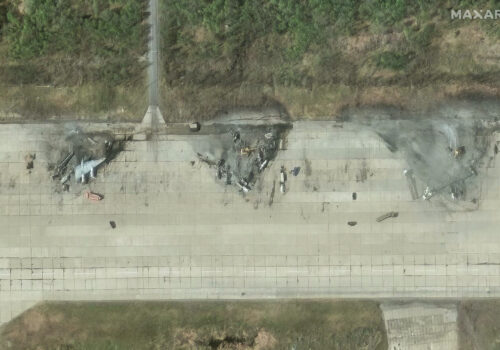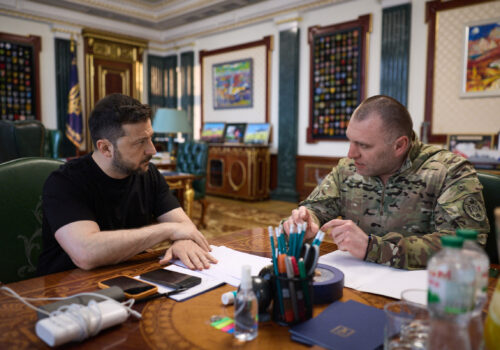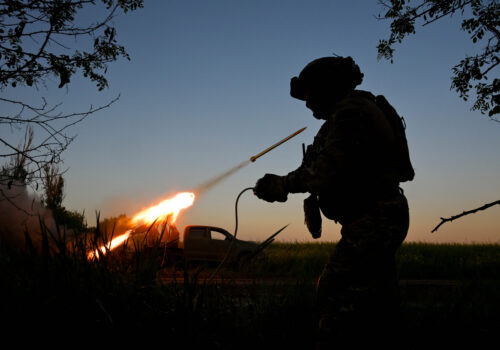This is part of a series of regular assessments of the efforts, spearheaded by the Trump administration, to achieve a negotiated end to Russia’s war on Ukraine. Read last week’s edition here.
KYIV—I arrived in Ukraine’s capital on June 1, several hours after news broke of the country’s successful destruction of advanced Russian bombers—TU-22s and TU-95s—and Russia’s most advanced intelligence plane, the A-50. Over the next two days, I had numerous meetings with senior Ukrainian officials, politicians, and civil society activists. The strike was a major morale boost across the board, though some of the Ukrainians I spoke with still worry whether the Trump administration will continue to supply military intelligence and equipment to Ukraine; others are optimistic that Trump will not let Russian President Vladimir Putin bamboozle him.
In the near term, the spectacular Ukrainian operation will have a major impact on Russia’s ability to strike from the air at Ukrainian civilian and military targets. It has also bolstered the nuclear security of the United States and its allies by taking out as much as 34 percent of Moscow’s nuclear-capable bomber force. But perhaps the greatest impact of the strike extends to the diplomacy to end the war, and in particular to the calculations of the Trump administration. That is because the strike undermined the common perception, including in the White House, that time was on Putin’s side and Russia would ultimately overwhelm Ukraine.
How has that big idea played out this week? It is notable that the only immediate reaction to the strike from Trump world came from outside actors, many of whom have shown little understanding that the Kremlin considers the United States to be its principal adversary. Some in this cohort have even naively argued that the United States has no stakes in its aggression against Ukraine. Trump allies Steve Bannon and Mike Flynn, for example, claim that Kyiv’s strike undermines Trump’s diplomacy to end the war. It is therefore time, in Bannon’s phrase, for the United States to “pull all support” for Ukraine. It should be noted that this was not a reflection of Trump’s policy. It was an attempt by some in his circle to influence that policy.
But Trump has not moved in that direction. In fact, the White House reaction to the audacious operation has been notably nuanced. The first word from the White House—almost a day after Ukraine’s “special military operation”—was that Ukrainian President Volodymyr Zelenskyy had not informed Trump of the impending action. There was no real comment on the action itself.
Reading between the lines with Putin and Merz
The next step was Trump’s June 4 phone call with Putin. In a Truth Social post afterward, Trump noted that it was a good call, but the Russian president was very angry about Ukraine’s attack and would have to retaliate. Trump critics understandably complained that there was no indication that the US president had tried to dissuade Putin from doing so—although the next day, the Washington Post reported that Trump claimed to have told Putin not to retaliate. In any case, Trump chose not to characterize the Ukrainian action.
That task was left to Trump’s special envoy for Ukraine, Keith Kellogg, who in a terse public statement on June 4 noted that the attack on Russia’s nuclear strike capacity could be considered escalatory. This was essentially a performative smack on the knuckles for Kyiv. More relevant indications of Trump’s reaction and inclinations were leaked to the press on background. While expressing to his staff his frustration with both Putin and Zelenskyy, Trump also recognized the audacity of the Ukrainian operation, calling it “badass,” according to Axios. Still, Trump reportedly lamented that it would slow down movement toward a cease-fire.
Further indications of Trump’s outlook came June 5, when he met with Friedrich Merz, the new German chancellor. Merz’s objective, of course, was to strengthen Trump’s resolve to maintain support for Ukraine (and to maintain the US commitment to NATO, including keeping US troops in Germany). In that meeting, Trump said it seems that Putin wants all of Ukraine, an important sign that he is finally understanding that the Russian leader himself is the obstacle to the administration’s efforts to end the war.
All of this is of far greater importance to the diplomacy surrounding the war than the second meeting of Ukrainian and Russian negotiators in Istanbul on June 2. That meeting went as expected. On the plus side, there was another agreement on a limited prisoner exchange. On the question of a cease-fire, the Russian side finally presented its formal terms. Those terms are for a vindictive, victor’s peace. Ukraine would be required not just to declare neutrality and demilitarize; it would also have to hand over to Russia all the territory in the eastern Ukrainian oblasts—including areas currently controlled by Kyiv. Moscow’s terms were likely on Trump’s mind as he discussed Putin’s policy toward Ukraine with Merz.
Whither the sanctions bill?
Trump’s clearer understanding of the Putin problem and his new respect for Ukraine’s military capabilities—“badass” being a backhanded but clear compliment—is a plus. But it has yet to yield a stronger policy from the White House.
Restive Republicans in Congress have been chafing for months at Trump’s reluctance to do what he promised: to bring pressure on the side blocking peace. Taking a leading position on this, Senator Lindsey Graham (R-SC) along with Senator Richard Blumenthal (D-CT) proposed a sanctions bill in early April with fifty cosponsors. That bill now has eighty-two cosponsors. Last week, Graham said that he thought the bill would move forward in the Senate this week. House Speaker Mike Johnson supports the effort for tough sanctions. Strong national security Republicans seem to believe that Ukraine’s successful June 1 strike is making it more likely that Congress will move on the sanctions bill and that the United States will help supply Ukraine with additional military equipment. Deft Ukrainian diplomacy on Capitol Hill this week—led by Zelenskyy’s chief of staff, Andriy Yermak—has further encouraged this sentiment.
Yet it is still not clear that the administration will move. The Wall Street Journal reported on June 6 that the White House asked for the sanctions bill to be watered down, and Trump indicated in his meeting with Merz that he is considering, for some unknown reason, sanctioning both sides. This means, at a minimum, some delay as Graham, Johnson, and other advocates try to work out their differences with the White House. It might also mean that Trump cannot bring himself to punish Putin.
That can only strengthen Putin’s conviction that Trump will eventually allow Russia to gobble up Ukraine. Reports that the Pentagon, with a leadership that is energetically trying to diminish ties with Ukraine, is transferring desperately needed anti-drone technology from Ukraine to US forces will also be read in the Kremlin as a sign of US weakness.
Ironically, Trump’s success at reaching a sustainable end to the war in Ukraine depends on the efforts of those advocates for pressure on Russia. Kellogg seemed to be making this point in a June 6 statement that the Ukrainian special operation could be a forcing function for peace. If, as Trump admitted, Putin’s goal is not a durable peace but to seize Ukraine, then the only real way to end the fighting is to make it very uncomfortable for Putin to continue fighting. Ukraine’s June 1 attack was a step in that direction. Strong US action in the form of sanctions and military supplies can drive that point home. Without that, the US president does not keep his long-stated promise to bring a stable peace to Europe.
John E. Herbst is the senior director of the Atlantic Council’s Eurasia Center and a former US ambassador to Ukraine.
Further reading
Thu, Jun 5, 2025
Ukraine just gave us a glimpse into the future of European defense
Inflection Points By Frederick Kempe
European allies need both military capabilities and technological innovation to deter Russia, as Ukraine’s recent drone strikes on Russian air bases underscore.
Sun, Jun 1, 2025
Dispatch from Kyiv: Ukraine’s daring drone attack gives Trump leverage against Putin
New Atlanticist By John E. Herbst
Ukraine’s June 1 drone strikes against five bases across Russia underscored its ingenuity and may help shape the negotiations to come.
Thu, May 29, 2025
Welcome to the long war: Why a Ukraine deal was never realistic
New Atlanticist By Brian Whitmore
There is no deal to be had with Russia on Ukraine—there never has been, and there never will be.
Image: Ukrainian Motherland Monument seen in Kyiv. Heat in Ukraine, another summer of massive war. People are trying to continue with the normality of their lives. Ximena Borrazas /SOPA Images via Reuters Connect.




